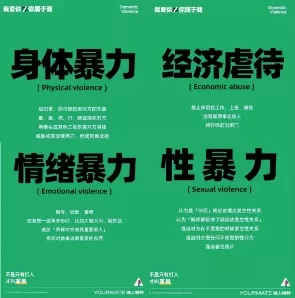「A Psychological Trap Disguised as Love」TED Talk Sharing: Why Domestic Violence Victims Don’t Leave
Why don’t you (domestic violence victim) leave?
Author: Roxi
Translator: Joey、Amy吴雯堃
This is an inspiring TED talk presented by an American writer, Leslie Morgan Steiner. She bravely told the story of her personal experience as a victim of domestic violence. This is a story of ” Crazy Love”, which is also known as a psychological trap disguised as love.
Most people have a misconception about the victims of domestic violence, and they often question the victims as if it’s their fault to be abused. For example, people might ask: “Why does she choose to stay?” “Why would anyone stay with a man who bet her? ”
I. What is domestic violence?
Domestic violence refers to the physical and emotional abuse between
family members by beating, tying up, restricting personal freedom, as well as
regular verbal abuse and intimidation.
The first
impression of domestic violence might be the obvious bruises, but domestic
violence is beyond physical abuse and injuries (Choices, n.d). Besides physical
violence, domestic violence is often accompanied by other forms of violence,
such as:
1.
Threatening and
Coercion
·
Destroying/damaging
the victim’s property and/or hurting their pets
·
Brandishing a weapon
of a dangerous nature on the victim
·
Threatening to kill
the victim or someone they know well
·
Threatening to
commit suicide
·
Threatening to
destroy the victim’s reputation in the public
2.
Emotional abuse
·
Denigrating the
victim in various ways
·
Making the victim
believe that they are mentally ill
·
Making the victim
feel guilty for the violence (e.g., “I deserve to be treated badly.”)
3.
Isolation
·
Limiting or
prohibiting the victim’s contact with the outside world
·
Surveilling the
victim’s daily life to justify the foregoing behaviours as being
“jealous”
4. Responsibility/ blame-shifting
·
Denying the
existence of the violence or not taking the act of domestic violence seriously
·
Shifting the
responsibility of the violence to the victim and keeps making excuses for
domestic violence
5.
Using the children
·
Using the child to
make the victim feel guilty
·
Threatening the
victim that they will take the child away
·
Using the child to
send messages to the victim
·
Using parenting time
with the child to harass the victim
6.
*Patriarchy (in fact,
women can also be the perpetrators of violence)
·
Treating the victim
like a private object, a servant or a slave
·
Asking the victim to
obey their instructions unconditionally; the victim has no say in family
decisions
7.
Economic control
·
Restricting/prohibiting
the victim from working or unilaterally subsidizing the family with own wages
for a long time
·
Victims have to
plead for a certain amount of money
·
Using the victim’s
property arbitrarily
·
The victim is not
allowed to know the actual financial status of the family
The domestic violence support websites in
the U.S. usually have a prominent “Escape” button, and this page will
automatically redirect to a “Not Found” page with just a single click. The
setting of this button indicates the stressful state and circumstances of the
victim’s life.
After understanding what domestic violence
is, let’s develop some insight into this issue by following Leslie’s Ted Talk.



II. Domestic violence is everywhere: it happens for people of different races, ages, and education levels.
It is a common belief that domestic violence
only occurs in poor and uneducated families. It seems distant from our daily
life. Whenever we watched the news or TV episodes related to domestic
violence, we might only be outraged for a moment. Then it becomes a brief
after-dinner conversation because we think it won’t happen in our own
surroundings. In fact, there must be someone around you who has
experienced/is experiencing domestic violence or even is the perpetrator of
domestic violence.
Leslie pursued an MBA degree from the
Houghton School of Business after graduating from Harvard University with a
degree in English. After graduation, she quickly got a job in Wall Street, and
she has
spent most of her career working for the Fortune 500 companies, including Johnson & Johnson and The Washington
Post. Though being a financially independent and outstanding woman, she is a
victim of suffering from chronic domestic violence.
According to a new
statistical report released by the United Nations Drug and Crime Agency
(UNODC), an average of 137 women across the world are killed by their partner
or family member every day. This makes “the home the most likely place for
women to be killed,” the report says.
·
According to WHO, ⅓ of women worldwide have experienced physical
or sexual violence, with less than 10% of them filing a police report in
2017.
·
Data from the All-China Women’s Federation shows that for every
7.4 seconds, a woman in China faced domestic violence in 2018. The average
number of times she suffered was 35 before she reported it to the police.
Women are
not the only victims of domestic violence
In the U.S., women ages 16-24 are three
times more likely to experience domestic abuse than other age counterparts; at
least 500 women and children die due to abuse every year. And 85 percent of the
perpetrators are men.
While the
United Nations Drug and Crime Agency (UNODC) report shows that men die in
homicide crimes four times as often as women, the proportion of women who die
in domestic or couple homicides is particularly striking, with eight out of ten
victims being female. The report says that “domestic violence
disproportionately affects women.”
Similarly,
not only women but also men can be victims of domestic violence. It is often
assumed that men are so strong and powerful that women were the weaker one
during their encounters with male. In fact, approximately 835,000 men are
victims of physical domestic violence in the United States each year. Most men
feel ashamed and embarrassed when they encounter this type of situation, and
when they seek help, they often receive unfair treatment. As a result, they
rarely admit to struggling with domestic violence and are much less likely to
seek help.
III. The signals of domestic violence
Step 1:
Seduce and Charm the Victim
The perpetrator of domestic violence does not start as
violent; instead, they often appear to be friendly and communicative in the
first place.
Leslie’s
ex-husband, who also graduated from an Ivy League school and worked at a
prestigious Wall Street bank, was an example of a perpetrator who put effort into creating a charming first
impression. Initially, he
pretended to appreciate Leslie’s good education and excellent workability,
making Leslie feel like she was the dominant one in the relationship and creating
a peculiar relationship of mutual trust.
For example, he will tell Leslie that
his childhood has been full of domestic abuse by his stepfather, expressing his
desire for parental love and wanting to build a happy and fulfilling family
with Leslie.
At this time, I believe that no one can ever think that
this man, who behaves so lovingly to his wife, will later inflict violence on
his partner.
Step 2:
Isolate the Victim
Keeping the victim away from family, friends, or any
familiar places gives the abuser a sense of security. In this situation, the
victim will become unconsciously dependent on the abuser and gradually find it
difficult to talk to others about their situation. Of course, there are various
ways to get victims to leave their familiar places voluntarily.
For example,
Leslie’s ex-husband told Leslie one day after work that he had quit his dream
job for Leslie because he had found his happiness and no longer needed to prove
his career success to others. He wanted Leslie to move to a small town with him
to start a new life and form a happy family.
Although Leslie
loved New York and her job, she resolutely chose to quit her job for the sake
of love and her hard-to-find soul mate, not knowing that she would fall into
the trap deliberately prepared by her ex-partner to control her mentally,
physically and financially.
Why do
victims choose to stay with their abusers rather than leaving?
First, the victims often do not initially realize they
are being abused because they believe the abuser is always in love with
them. They believe the abuser may be under great stress and emotional
distress, and the victims believe that they are the only ones in the world who
can help and save the abuser.
After the first
domestic violence incident, the victim will show uncontrollable anger and
sadness, they may want to choose to break up or leave the abuser. At this time,
the abuser will keep apologizing and showing endless remorse in order to get
them back, and may even choose to kneel down and attempt suicide in order to
gain the victim’s forgiveness. They will also attempt to reassure the victim
that it was just a random incident and that there were some valid reasons for
the violence to occur.
Hopefully, every victim of abuse could remember that
there are only either 0 or countless times of domestic violence. After
experiencing domestic abuse several times, why doesn’t the victim choose to
escape?
Leslie speaks
out about a problem that bystanders never realize or appreciate, and that is,
“It is incredibly dangerous to leave the abusers.
Step 3: Kill
the Victim
According to statistics, over 70% of domestic violence
murders occur after the victim has expressed a desire to end the relationship.
The abuser may become angry at the betrayal, leading to unconventional
situations including prolonged stalking, denial of financial support, threats
and intimidation.
Researchers have
collected information on approximately 340,000 female clients through more than
70 domestic violence agencies in Illinois and found that only about 10 percent
of the clients approached domestic violence agencies on their own. Forty
percent of these clients were referred by police officers (Lundy &
Grossman, 2009).



How to get out of domestic violence?
The key to saving victims of domestic
violence is to “break the silence.” This depends on the victims
themselves as well as the help of others.
As Leslie said at the end of her speech,
“Tell someone what you heard today. Abuse Thrives Only in Silence. You
have the power to stop domestic violence; you just need to light the fire, we
victims need everyone’s help, and more people need to understand the secret of
domestic violence. Discuss this topic with your children, with your colleagues,
with your family and friends, and bring the abuse to light. Help the victim to
find a better and loving self again and to look forward to a new future.
Recognize the violent pattern, intervene at your best, reduce the likelihood of
recurring violence, and provide the victim with a safe way out.”
So, if you are a victim of domestic violence
or someone close to you is suffering, please be brave and speak up, break the
silence, save yourself, and save others.
References
Choices(n.d) Choices, for victims of domestic violence. Retrieved from http://choicescolumbus.org
Lundy, M., & Grossman, S. (2009). Domestic violence service users: a comparison of older and younger women victims. Journal Of Family Violence, 24(5), 297-309. doi:10.1007/s10896-009-9230-y
泓兮. (2015). 家暴的受害者为什么不选择离开所在家庭?知乎. Retrieved fromhttps://www.zhihu.com/question/23507158/answer/54826143
宋宇晟. (2019). 中国每7.4秒就有1位女性被家暴,我们对家暴无能为力吗?中国新闻网. Retrieved from http://www.xinhuanet.com/legal/2019-11/28/c_1125282677.htm











